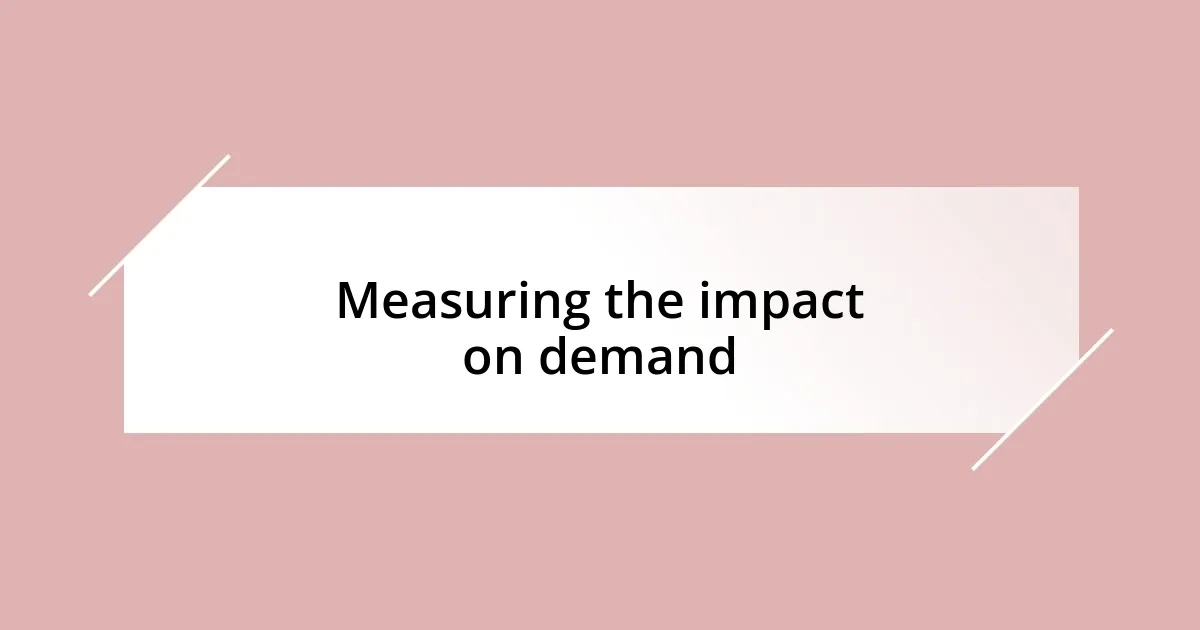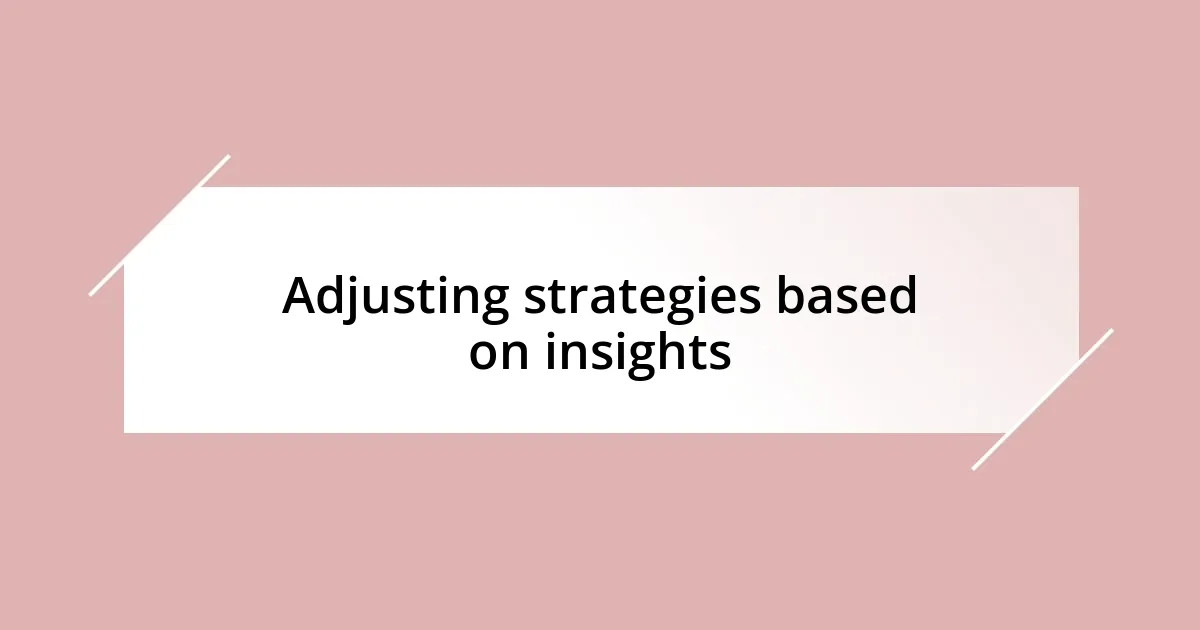Key takeaways:
- Data empowers informed decision-making, shifting strategies from instinct-based to evidence-based.
- Identifying and analyzing diverse data sources (surveys, sales, social media) enhances understanding of customer preferences and behaviors.
- Implementing data-driven marketing strategies, like segmentation and A/B testing, leads to improved engagement and sales performance.
- Adjusting strategies based on customer insights, such as evolving preferences and pain points, drives demand and strengthens brand connection.

Understanding the importance of data
Data isn’t just numbers; it’s the heartbeat of informed decision-making. I remember a time when I was launching a new product without much data to back my choices. It felt like sailing in the dark. That experience taught me the real weight data holds in reducing uncertainty and guiding us toward smarter strategies.
When I started analyzing customer behavior through data, it was like flipping a switch. I could see patterns and preferences I had previously overlooked. Have you ever noticed how a simple number can transform your understanding of your audience? It’s surreal to think that a few clicks could reveal so much about what your customers truly want.
I’ve often found that relying on gut feelings can lead to missed opportunities. Once, I took a risk with a campaign based purely on intuition, and it fell flat. In retrospect, if I had embraced data-driven insights, I could have adjusted my approach to resonate more with my audience’s needs. Data empowers us to turn risks into calculated steps, ensuring we don’t just keep up, but actually thrive in a competitive landscape.

Identifying key data sources
Identifying key data sources is essential for any successful strategy. I’ve learned that not all data is created equal. For instance, while website analytics can provide quantitative insights, social media interactions often unveil qualitative emotions behind those numbers. It was during a project where I was sifting through customer feedback that I realized how much sentiment analysis could inform our messaging—suddenly the data felt not just informative but alive.
When I began to map out the various sources of data available to me, I prioritized a few key ones: customer surveys, sales records, and competitor analysis. Each of these sources provided unique insights. Take customer surveys, for example. They can reveal direct preferences and pain points, helping me hone in on specific areas for improvement. I’ll never forget a survey response that highlighted a feature customers craved but we hadn’t considered—a game-changer for our next update.
I always recommend looking at both external and internal data sources when strategizing. External sources, like industry reports and market trends, can offer broader context, while internal data unearths specific opportunities within your existing framework. This blend of perspectives has transformed my approach to market analysis. It’s all about creating a comprehensive picture to effectively boost demand.
| Data Source | Insights Offered |
|---|---|
| Customer Surveys | Direct feedback on preferences and pain points |
| Sales Records | Quantitative performance indicators |
| Competitor Analysis | Industry positioning and strategic opportunities |

Analyzing customer behavior trends
Analyzing customer behavior trends has been a real eye-opener for me. I recall a specific time when I began tracking user interactions with our website. The insights were astounding—certain products had higher click-through rates during specific times of the day. It made me realize that behavior isn’t just seasonal; it’s temporal, too. Understanding these nuances has enabled me to tailor our marketing efforts much more effectively.
Here are some key behaviors I learned to analyze:
- Peak Interaction Times: Identifying when customers are most active helps optimize marketing campaigns for maximum exposure.
- Purchase Pathways: Analyzing how customers navigate our site unveils common routes to purchase, illuminating possible roadblocks along the way.
- Engagement Metrics: Monitoring how often users engage with emails or social media posts provides insights into their interest levels and helps refine our messaging.
- Feedback Trends: Regularly reviewing customer feedback highlights emerging needs and preferences, allowing for timely adjustments to our offerings.
By diving deep into these trends, I’ve felt empowered to innovate and adapt, keeping our strategies fresh and aligned with what truly resonates with our audience.

Implementing data-driven marketing strategies
Implementing data-driven marketing strategies is where the magic really happens. One time, I decided to segment our email list based on customer purchasing behavior. Suddenly, instead of sending a blanket message, we were able to tailor promotions specifically to different user groups. The result? A surge in open rates and a significant boost in sales. Doesn’t it feel rewarding to see your efforts translate directly into results like that?
As I dove deeper into our marketing strategies, I leveraged A/B testing to experiment with different campaign visuals and messaging. Through this process, I could sense the excitement building when one variant outperformed another. Wouldn’t it be great to know exactly what resonates with your audience? I found that consistent testing not only improved our engagement rates but also built confidence in our decision-making. Every test felt like mini-experiments that brought us closer to understanding our customer’s preferences.
In my experience, tracking campaign performance through metrics like conversion rates and customer acquisition cost became essential. I remember the thrill when we analyzed a particular campaign that exceeded our expectations. It made me ask: how can we replicate that success? Exploring these metrics allows us to pivot quickly and adapt strategies in real-time, ensuring that we remain relevant in a fast-paced market. After all, isn’t adapting your approach to meet evolving customer needs a key ingredient in boosting demand?

Measuring the impact on demand
Measuring the impact on demand can initially feel like staring into a foggy mirror. I vividly recall the first time we tried tracking conversion rates post-campaign; the numbers were all over the place. It was a mix of anticipation and confusion. Yet, with each analysis, clarity began to emerge. The excitement of pinpointing what actually drove sales was undeniable. Seeing those trends change in response to adjustments we made felt like solving a complex puzzle where every piece mattered.
One day, after a campaign that had underperformed, I decided to dig deeper into our data. I discovered that customer retention metrics were telling a different story. It was like a light bulb went off—here were returning customers who were eager to re-engage, but we weren’t capitalizing on that. Could it be that a simple follow-up email might rekindle their interest? After implementing a strategy focused on nurturing these relationships, we saw a noticeable uptick in demand, and I remember grinning from ear to ear when our repeat purchase rate soared.
In my journey, I’ve learned to embrace the feedback loop that data provides. Feedback isn’t just a set of numbers; it’s the voice of our customers. I often ask myself: how can we be more attuned to their needs? When we meticulously measure and react to this feedback, it creates a cycle of continuous improvement. Each time I see demand rise following a strategic pivot based on our findings, it solidifies my belief that measuring impact isn’t just a task—it’s a vital lifeline to our market success.

Adjusting strategies based on insights
One pivotal moment in adjusting my strategies based on insights was when I realized that our target audience was evolving. I remember analyzing customer feedback and noticing a growing interest in sustainability. This insight prompted me to shift our messaging to highlight eco-friendly practices. The immediate response was heartening; our engagement levels reflected a deeper connection with our brand. Isn’t it fascinating how paying attention to subtle shifts can lead to such impactful changes?
Then there was the time I discovered that our social media engagement dipped after switching our posting schedule. It was puzzling at first until I went back through the data. I noticed our audience was most active in the evenings. Adapting our strategy to post during those peak times rekindled the conversation with our followers. It made me wonder: how often do we overlook the basics in our quest for innovation? Simple adjustments based on insightful observations can yield surprisingly powerful results, reminding me that sometimes, the answer is right in front of us.
In another instance, I analyzed customer journey data and realized we were losing potential buyers at the checkout phase. That was a wake-up call! I decided to refine the user experience by simplifying the checkout process and providing clearer communication about shipping costs. The subsequent increase in completed purchases left me elated. It goes to show that understanding your audience’s journey is critical; how can we expect to meet their needs if we don’t walk the path with them? Adjusting strategies based on these insights truly transformed our approach, making our efforts more effective and rewarding.














